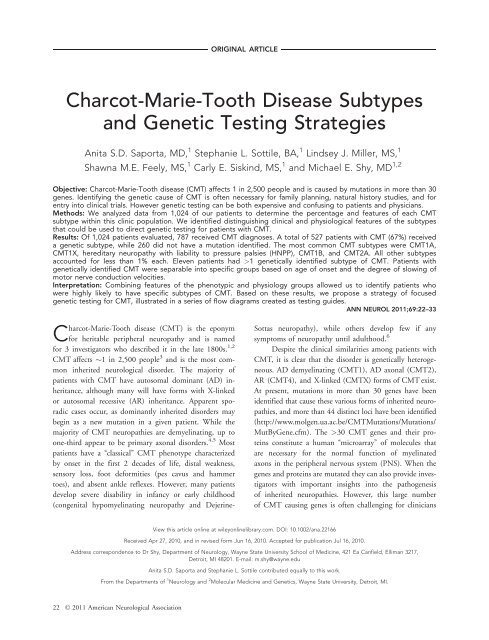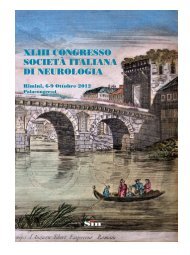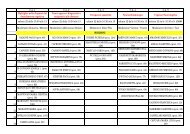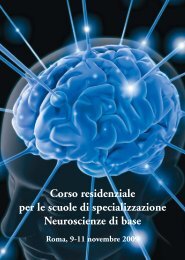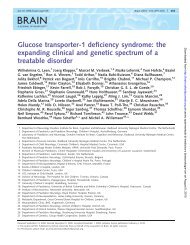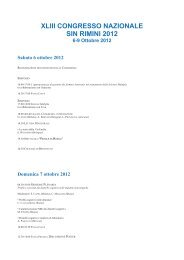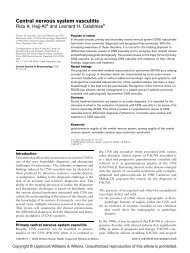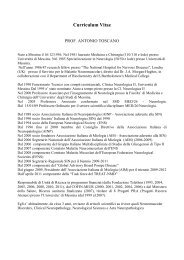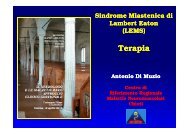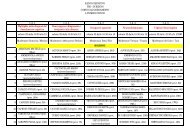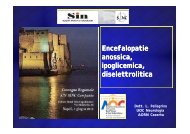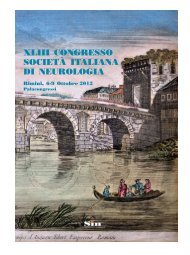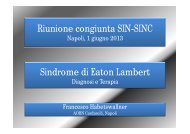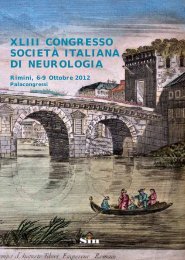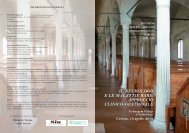Charcot-Marie-Tooth disease subtypes and genetic ... - ResearchGate
Charcot-Marie-Tooth disease subtypes and genetic ... - ResearchGate
Charcot-Marie-Tooth disease subtypes and genetic ... - ResearchGate
Create successful ePaper yourself
Turn your PDF publications into a flip-book with our unique Google optimized e-Paper software.
ORIGINAL ARTICLE<strong>Charcot</strong>-<strong>Marie</strong>-<strong>Tooth</strong> Disease Subtypes<strong>and</strong> Genetic Testing StrategiesAnita S.D. Saporta, MD, 1 Stephanie L. Sottile, BA, 1 Lindsey J. Miller, MS, 1Shawna M.E. Feely, MS, 1 Carly E. Siskind, MS, 1 <strong>and</strong> Michael E. Shy, MD 1,2Objective: <strong>Charcot</strong>-<strong>Marie</strong>-<strong>Tooth</strong> <strong>disease</strong> (CMT) affects 1 in 2,500 people <strong>and</strong> is caused by mutations in more than 30genes. Identifying the <strong>genetic</strong> cause of CMT is often necessary for family planning, natural history studies, <strong>and</strong> forentry into clinical trials. However <strong>genetic</strong> testing can be both expensive <strong>and</strong> confusing to patients <strong>and</strong> physicians.Methods: We analyzed data from 1,024 of our patients to determine the percentage <strong>and</strong> features of each CMTsubtype within this clinic population. We identified distinguishing clinical <strong>and</strong> physiological features of the <strong>subtypes</strong>that could be used to direct <strong>genetic</strong> testing for patients with CMT.Results: Of 1,024 patients evaluated, 787 received CMT diagnoses. A total of 527 patients with CMT (67%) receiveda <strong>genetic</strong> subtype, while 260 did not have a mutation identified. The most common CMT <strong>subtypes</strong> were CMT1A,CMT1X, hereditary neuropathy with liability to pressure palsies (HNPP), CMT1B, <strong>and</strong> CMT2A. All other <strong>subtypes</strong>accounted for less than 1% each. Eleven patients had >1 <strong>genetic</strong>ally identified subtype of CMT. Patients with<strong>genetic</strong>ally identified CMT were separable into specific groups based on age of onset <strong>and</strong> the degree of slowing ofmotor nerve conduction velocities.Interpretation: Combining features of the phenotypic <strong>and</strong> physiology groups allowed us to identify patients whowere highly likely to have specific <strong>subtypes</strong> of CMT. Based on these results, we propose a strategy of focused<strong>genetic</strong> testing for CMT, illustrated in a series of flow diagrams created as testing guides.ANN NEUROL 2011;69:22–33<strong>Charcot</strong>-<strong>Marie</strong>-<strong>Tooth</strong> <strong>disease</strong> (CMT) is the eponymfor heritable peripheral neuropathy <strong>and</strong> is namedfor 3 investigators who described it in the late 1800s. 1,2CMT affects 1 in 2,500 people 3 <strong>and</strong> is the most commoninherited neurological disorder. The majority ofpatients with CMT have autosomal dominant (AD) inheritance,although many will have forms with X-linkedor autosomal recessive (AR) inheritance. Apparent sporadiccases occur, as dominantly inherited disorders maybegin as a new mutation in a given patient. While themajority of CMT neuropathies are demyelinating, up toone-third appear to be primary axonal disorders. 4,5 Mostpatients have a ‘‘classical’’ CMT phenotype characterizedby onset in the first 2 decades of life, distal weakness,sensory loss, foot deformities (pes cavus <strong>and</strong> hammertoes), <strong>and</strong> absent ankle reflexes. However, many patientsdevelop severe disability in infancy or early childhood(congenital hypomyelinating neuropathy <strong>and</strong> Dejerine-Sottas neuropathy), while others develop few if anysymptoms of neuropathy until adulthood. 6Despite the clinical similarities among patients withCMT, it is clear that the disorder is <strong>genetic</strong>ally heterogeneous.AD demyelinating (CMT1), AD axonal (CMT2),AR (CMT4), <strong>and</strong> X-linked (CMTX) forms of CMT exist.At present, mutations in more than 30 genes have beenidentified that cause these various forms of inherited neuropathies,<strong>and</strong> more than 44 distinct loci have been identified(http://www.molgen.ua.ac.be/CMTMutations/Mutations/MutByGene.cfm). The >30 CMT genes <strong>and</strong> their proteinsconstitute a human ‘‘microarray’’ of molecules thatare necessary for the normal function of myelinatedaxons in the peripheral nervous system (PNS). When thegenes <strong>and</strong> proteins are mutated they can also provide investigatorswith important insights into the pathogenesisof inherited neuropathies. However, this large numberof CMT causing genes is often challenging for cliniciansView this article online at wileyonlinelibrary.com. DOI: 10.1002/ana.22166Received Apr 27, 2010, <strong>and</strong> in revised form Jun 16, 2010. Accepted for publication Jul 16, 2010.Address correspondence to Dr Shy, Department of Neurology, Wayne State University School of Medicine, 421 Ea Canfield, Elliman 3217,Detroit, MI 48201. E-mail: m.shy@wayne.eduAnita S.D. Saporta <strong>and</strong> Stephanie L. Sottile contributed equally to this work.From the Departments of 1 Neurology <strong>and</strong> 2 Molecular Medicine <strong>and</strong> Genetics, Wayne State University, Detroit, MI.22 VC 2011 American Neurological Association
Saporta et al: Detecting CMT Subtypes<strong>and</strong> patients. There is little information available to guideus as to which gene to test, <strong>and</strong> testing a patient for mutationsin all commercially available CMT genes is not costeffective. Nevertheless, family planning <strong>and</strong> prognosis oftenrequire an accurate <strong>genetic</strong> diagnosis <strong>and</strong> currenttreatment trials depend on knowing the <strong>genetic</strong> cause ofa patient’s CMT even if no cures are presently available.Currently we have evaluated >1,000 patients with CMTin our clinic, many of whom have had <strong>genetic</strong> testing.We elected to analyze the results of <strong>genetic</strong> testing performedon these patients; first, to determine whether wecould analyze our phenotypic data to focus <strong>genetic</strong> testingfor patients we evaluate in the future, <strong>and</strong> second, toensure that our patient population was representative ofthose screened by various diagnostic laboratories. Wehave developed an algorithm based on clinical phenotypes,neurophysiology, <strong>and</strong> prevalence that we proposeas a guide to help focus <strong>genetic</strong> testing for various formsof CMT.Patients <strong>and</strong> MethodsCharacterization of CMT SubtypesWe included all patients evaluated at our CMT clinic between1997 <strong>and</strong> 2009. Patients were considered to have CMT if theyhad a sensorimotor peripheral neuropathy <strong>and</strong> a family historyof a similar condition. Patients without a family history of neuropathywere included if their medical history, neurophysiologicaltesting, <strong>and</strong> neurological examination were typical forCMT1, CMT2, CMTX, or CMT4. Patients were excluded ifthere were known diagnoses of acquired neuropathy includingtoxic (eg, medication-related neuropathies); metabolic (eg, diabetic),immune mediated or inflammatory (AIDP or CIDP)polyneuropathies; neuropathy related to leukodystrophy, or congenitalmuscular dystrophy; <strong>and</strong> patients with severe generalmedical conditions. First-degree or second-degree relatives of<strong>genetic</strong>ally defined patients with a CMT phenotype wereassumed to have the same mutation. Patients without an identified<strong>genetic</strong> cause were classified based on nerve conductionvelocities, physical examination, <strong>and</strong> family history.This study was approved by the Institutional ReviewBoard (IRB) at Wayne State University.Genetic Testing Hit RatesData was collected on patients for whom commercial <strong>genetic</strong>testing was ordered by Wayne State University between 2005<strong>and</strong> 2009. Hit rates were defined as the number of positiveresults for a particular gene, out of the total number of times<strong>genetic</strong> testing was ordered for that gene. As our experiencewith different <strong>subtypes</strong> of CMT has grown we have incorporatedphenotypic characteristics in our decision-making for<strong>genetic</strong> testing. Our criteria for which genes to test has evolvedover the years <strong>and</strong> our ‘‘hit rates’’ should be interpreted withthis in mind. Patients who had previously obtained positiveTABLE 1: CMT Subtype DistributionCMTSubtypenPatients withGenetically-Defined CMT(n 5 527) (%)All Patientswith CMT(n 5 787)(%)CMT1A 290 55.0 36.9CMT1B 45 8.5 5.7CMT1X 80 15.2 10.2Males 44 8.4 5.6Females 36 6.8 4.6CMT2A 21 4.0 2.7HNPP 48 9.1 6.1Total 484 91.8 61.5CMT ¼ <strong>Charcot</strong>-<strong>Marie</strong>-<strong>Tooth</strong> <strong>disease</strong>; HNPP ¼ hereditaryneuropathy with liability to pressure palsies.<strong>genetic</strong> testing for their type of CMT were not included in thehit rate analysis but were included in our phenotypic analysis.ResultsDistribution of CMT SubtypesA total of 1,024 patients were evaluated at our CMTclinic between 1997 <strong>and</strong> 2009, of which 787 were diagnosedwith CMT. Of the 237 patients who did not haveCMT, 118 were diagnosed with a different conditionwhile 119 were determined to be an unaffected familymember of a patient with CMT.Of the 787 patients with CMT (67%), 527patients had or received a specific <strong>genetic</strong> diagnosis, whilein 260 patients with CMT no specific mutation wasidentified. The most prominent CMT <strong>subtypes</strong> identifiedin our clinic were CMT1A, CMT1X, hereditary neuropathywith liability to pressure palsies (HNPP), CMT1B,<strong>and</strong> CMT2A (Table 1). All other CMT <strong>subtypes</strong>accounted for less than 1% of all patients with <strong>genetic</strong>allydefined CMT each. Only 1.8% of patients withCMT1 were without a <strong>genetic</strong> diagnosis. These patientswere defined as having a demyelinating phenotype <strong>and</strong> adominant family history. Of patients with CMT2,65.6% were without a <strong>genetic</strong> diagnosis. These patientswere defined as having an axonal phenotype <strong>and</strong> a dominantfamily history (Table 2). The distribution of <strong>genetic</strong><strong>subtypes</strong> identified in our clinic was similar to the distributionof patients identified by multiple laboratories thatperform diagnostic testing for CMT (reviewed in Engl<strong>and</strong><strong>and</strong> colleagues 7,8 ). Comparing our results to thosefrom these laboratories (their results follow in parentheses),we identified CMT1A in 82% (80%) of patientsJanuary 2011 23
ANNALS of NeurologyTABLE 2: CMT1, 2, <strong>and</strong> 4 SubtypesCMT Types n Patients byCMT Type (%)Patients with GeneticallyDefined CMT(n 5 527) (%)CMT Type 1 groupCMT1A 290 66.8 55.0 36.9CMT1B 45 10.4 8.5 5.7CMT1C 5 1.2 1.0 0.6CMT1D 1 0.2 0.2 0.1CMT1E 5 1.2 1.0 0.6CMT1X 80 18.4 15.2 10.2Males 44 10.1 8.4 5.6Females 36 8.3 6.8 4.6Total 426 98.2 80.8 54.1CMT1 Unknown 8 1.8 – 1.0Total 434 – – 55.2CMT Type 2 groupCMT2A 21 21.9 4.0 2.7CMT2D 3 3.1 0.6 0.4CMT2E 4 4.2 0.8 0.5CMT2K 5 5.2 1.0 0.6Total 33 34.4 6.3 4.2CMT2 Unknown 63 65.6 – 8.0Total 96 – – 12.2CMT Type 4 groupCMT4A 1 14.3 0.2 0.1CMT4C 3 42.9 0.6 0.4CMT4F 1 14.3 0.2 0.1CMT4J 2 28.6 0.4 0.3Total 7 – 1.4 0.9CMT ¼ <strong>Charcot</strong>-<strong>Marie</strong>-<strong>Tooth</strong> <strong>disease</strong>.All Patientswith CMT(n 5 787) (%)with clinically probable CMT1, as well as CMT1X in10% (12%) <strong>and</strong> CMT1B in 6% (5%) of all patientswith CMT. The practice parameter guideline cited just 1study that identified MFN2 mutations in 33% of allpatients with CMT2. 9 However, multiple other studieshave identified MFN2 mutations in approximately 20%of their patients with CMT2, 10–12 similar to the 21%that we found in our clinic population.Diagnosing AR conditions was difficult becausecommercial testing is not available in the United States forall forms of AR CMT, <strong>and</strong> research laboratories to testremaining forms are not readily available. However, wewere able to diagnose 7 patients with AR CMT, accountingfor 0.90% of all patients with CMT (see Table 2).Additionally, we have 25 affected siblings without parentsor other family members affected with CMT who aretherefore likely to have AR inheritance for which we haveno <strong>genetic</strong> diagnosis. If these patients were included in ouranalysis, up to 4% of our patients with CMT would haveAR CMT. In addition, we have 77 patients without a familyhistory who are therefore classified as having sporadicCMT, some of whom also may have an AR disorder.We detected 11 patients with more than 1 subtypeof CMT, as identified by <strong>genetic</strong> testing. These patients24 Volume 69, No. 1
Saporta et al: Detecting CMT SubtypesTABLE 3: Patients with Multiple CMT SubtypesCMTSubtypesnAffectedFamilies (n)Patients with GeneticallyDefined CMT(n 5 527) (%)CMT1A/1E 5 2 1.0 0.6CMT1E/1B 3 1 0.6 0.4CMT1X/1B 2 2 0.4 0.3CMT1A/1C 1 1 0.2 0.1Total 11 6 2.1 1.4CMT ¼ <strong>Charcot</strong>-<strong>Marie</strong>-<strong>Tooth</strong> <strong>disease</strong>.All Patientswith CMT(n 5 787) (%)accounted for 1.4% of all patients with CMT (Table 3).Not all patients were tested for multiple mutations.We were unable to identify a <strong>genetic</strong> cause in 33%of our patients with CMT. These patients were classifiedbased on nerve conduction velocities, physical examination,<strong>and</strong> family history (Table 4).Genetic Testing Hit Rates <strong>and</strong> Methodsfor Targeted TestingTo determine our effectiveness in identifying the <strong>genetic</strong>causes of CMT, we retrospectively calculated the percentageof times we correctly identified CMT-causing mutationsin commercially available CMT genes. These ‘‘hitrates’’ were highest in investigations for CMT1A orHNPP. Genetic testing for the duplication or deletion ofPMP22 was ordered 40 times, 32 of which yielded a positiveresult (80%), the highest hit rate for any <strong>genetic</strong>test. Of these 32 positive results, 26 (81%) were duplicationsof PMP22 causing CMT1A, <strong>and</strong> 6 (19%) weredeletions of PMP22 causing HNPP (Table 5).MPZ sequencing was ordered 31 times, 9 of whichyielded a positive result (29%); GJB1 sequencing was ordered25 times, 6 of which yielded a positive result(24%); MFN2 testing was ordered 48 times, 6 of whichyielded a positive result (13%); <strong>and</strong> PMP22 sequencingwas ordered 18 times, 2 of which yielded a positive result(11%) (see Table 5).Phenotypic AssociationsMost of our patients with CMT clustered into 3 broadphenotypic groups based on the age of symptom onset(Table 6). The first group we have characterized as the‘‘classical phenotype,’’ based on the descriptions of Harding<strong>and</strong> Thomas. 4,5 Affected patients with a classicalphenotype begin walking on time, usually by 1 year to15 months of age, <strong>and</strong> develop weakness or sensory lossduring the first 2 decades of life. Impairment slowlyincreases thereafter, <strong>and</strong> rarely do patients require ambulationaids beyond ankle foot orthotics (AFOs). 13,14 Over60% of our patients with CMT1A <strong>and</strong> 67.5% of malesTABLE 4: Genetically Undefined CMTCategorization n Patients with GeneticallyUndefined CMT(n 5 260) (%)Demyelinating dominant inheritance 8 3.1 1.0Demyelinating undetermined inheritance 19 7.3 2.4Axonal dominant inheritance 63 24.2 8.0Axonal undetermined inheritance 61 23.5 7.8Intermediate dominant inheritance 31 11.9 4.0Intermediate undetermined inheritance 22 8.5 2.8Hereditary motor neuropathies 7 2.7 0.9Hereditary sensory neuropathies 17 6.5 2.2Other 14 5.4 1.8CMT ¼ <strong>Charcot</strong>-<strong>Marie</strong>-<strong>Tooth</strong> <strong>disease</strong>.All Patientswith CMT(n 5 787) (%)January 2011 25
ANNALS of NeurologyTABLE 5: Genetic Testing ‘‘Hit’’ RatesGenetic TestNumberof TimesOrderedNumberof HitsHitRate(%)PMP2240 32 80duplication/deletionPMP22 sequencing 18 2 11MPZ sequencing 31 9 29GJB1 sequencing 25 6 24MFN2 sequencing 51 7 14GJB1 ¼ gap junction beta-1 gene; MFN2 ¼ mitofusin-2gene; MPZ ¼ myelin protein zero gene; PMP22 ¼ peripheralmyelin protein 22 gene.with CMT1X 15 fell into this category, whereas this phenotypewas less common for patients with CMT1B(14.6%).The second phenotype we defined as infantile onsetin which patients do not begin walking until they are atleast 15 months of age. These patients are often severelyaffected <strong>and</strong> are likely to require above the knee bracing,walkers, or wheelchairs for ambulation by 20 years ofage. Over 35% of our patients with CMT1B fell intothis category. 16The third phenotype was defined as adult onset, inwhich patients did not develop symptoms of CMT untiladulthood, often not until approximately 40 years of age.An additional large group of patients with CMT1B(50%) <strong>and</strong> 56% of women with CMT1X fell into thiscategory. 16Physiology AssociationsWe previously reported that specific <strong>genetic</strong> forms ofCMT display characteristic patterns of motor nerve conductionvelocities (MNCV) in their upper extremities. 17For example, most patients with CMT1A have uniformlyslowed MNCV between 20 <strong>and</strong> 25m/second, 13 mostpatients with CMT1B have either very slow (15 m/second)or else nearly normal MNCV, 16 <strong>and</strong> most maleswith CMT1X have intermediately slow MNCV between30 <strong>and</strong> 45m/second. 15 We therefore investigated whethera careful grouping of MNCV in the upper limb wouldalso prove useful in predicting which genes to screen forin patients with CMT. We separated our 787 patientswith CMT into 4 groups: (1) those with normal MNCV(>45 m/second); (2) those with mild or ‘‘intermediate’’slowing (>35 <strong>and</strong> 45 m/second); (3) those with slowMNCV (>15 <strong>and</strong> 35 m/second); <strong>and</strong> (4) those withvery slow MNCV (15 m/second). We then investigatedthe number <strong>and</strong> percentage of genotypes identifiedwithin these groups. Patients with slow MNCV rangewere then subdivided into those with velocities of >15<strong>and</strong> 25 m/second <strong>and</strong> >25 <strong>and</strong> 35 m/second.Results confirmed that different CMT genotypeshave characteristic MNCV patterns (Table 7). Over 76%of patients with CMT1A had MNCV in the slow rangeTABLE 6: CMT Based on Age of OnsetCMTSubtypesChildhood Onset Adult Onset Subtotal a Subclinical b Unknown TotalAge Onsetof Walking15 moAge Onsetof Walking
Saporta et al: Detecting CMT SubtypesTABLE 7: CMT Based on Ulnar MNCVCMTSubtypesUlnar MNCV (m/sec) NR NotVery Slow Slow Intermediate Normal Subtotal a Tested b15 >15 <strong>and</strong> >25 <strong>and</strong> >35 <strong>and</strong> >4525 35 45CMT1A 61 (23.4%) e 162 (62.1%) 38 (14.6%) – – 261 12 17 290CMT1B 8 (20.5%) 4 (10.3%) 2 (5.1%) 11 (28.2%) 14 (35.9%) 39 2 4 45CMT1X – 4 (5.3%) 17 (22.7%) 19 (25.3%) 35 (46.7%) 75 1 4 80Males – 4 (9.8%) 17 (41.5%) 13 (31.71%) 7 (17.1%) 41 1 2 44Females – – – 6 (17.7%) 28 (82.4%) 34 – 2 36CMT2A – – – – 8 (100%) 8 8 5 21HNPP – – – 7 (14.9%) 40 (85.1%) 47 0 1 48All percentages in the table were calculated using the subtotal value for each CMT subtype.a All tested cases with obtainable responses.b Exam refused.CMT ¼ <strong>Charcot</strong>-<strong>Marie</strong>-<strong>Tooth</strong> <strong>disease</strong>; HNPP ¼ hereditary neuropathy with liability to pressure palsies; NR ¼ not recordable.Totalwhereas only 23% were in the very slow group <strong>and</strong> nopatient with CMT1A was in the intermediate or normalgroups. Fifteen percent of patients with CMT1B were inthe slow group while 21% of patients with CMT1Bwere in the very slow group <strong>and</strong> 64% were in the intermediateor normal range. For males with CMT1X, 51%had MNCV of >15 <strong>and</strong> 35 m/second. Most (81%) ofthese were in the >25 <strong>and</strong> 35 m/second group. Nowoman with CMT1X had MNCV in the slow range,18% had MNCV in the intermediate range, <strong>and</strong> 82%had MNCV in the normal range. All patients withHNPP were in the intermediate or normal range as werethose patients with CMT2A in whom compound muscleaction potential (CMAP) amplitudes could be identified.Phenotype Combined with PhysiologyFinally, we investigated whether combining phenotypicdata with physiology further improved our ability to predictan accurate <strong>genetic</strong> diagnosis (Table 8). We foundthat virtually all patients (154/173, 89%) with bothMNCV in the >15 <strong>and</strong> 35 m/second range <strong>and</strong> theonset of walking prior to 15 months of age hadCMT1A. In addition, 89.5% (154/172) of patients withCMT1A who had MNCV in the >15 <strong>and</strong> 35 m/secondrange began walking prior to 15 months of age.When slow MNCV were subdivided, 96.9% (123/127)of patients who walked prior to 15 months of age <strong>and</strong>had MNCV between >15 <strong>and</strong> 25 m/second hadCMT1A. Onset of walking data was available for 53patients with CMT1A <strong>and</strong> very slow MNCV (15 m/second). Sixty-eight percent (36/53) of patients in thisgroup began walking before 15 months. Additionally, 17patients in this group with CMT1A had delayed walking.All patients with CMT1B <strong>and</strong> very slow MNCV haddelayed walking. However, because CMT1A is so common,there were still more patients with CMT1A (17) inthis group than patients with early onset CMT1B (8).Two-thirds of males with CMT1X began walkingbefore 15 months <strong>and</strong> had MNCV in the >25 <strong>and</strong>45 m/second range. There was no obvious correlationbetween MNCV <strong>and</strong> the onset of walking with CMT1X.Patients with late onset CMT1B were likely to haveMNCV in the >35 m/second range <strong>and</strong> not to developsymptoms until adulthood. No late onset patient withCMT1B had MNCV in the very slow range <strong>and</strong> only 2had values in the slow range. No patient with CMT1B<strong>and</strong> intermediate or normal MNCV had delayed walking<strong>and</strong> no patient with CMT1A had MNCV in the intermediateor normal range. All patients with CMT2A whohad detectable motor potentials in the arms had MNCVin the normal range <strong>and</strong> developed symptoms in infancyor childhood. Any patient with unobtainable potentials,including a number of patients with CMT2A, was notincluded in Table 8.DiscussionThis analysis of over 1,000 patients demonstrated thatclinical <strong>and</strong> neurophysiologic information could be usefulin focusing <strong>genetic</strong> testing for CMT. By characterizingcommon phenotypes for particular forms of CMT, thesedata can also be useful in determining whether a givenpatient is typical or unusual for a particular genotype.Recently, a practice parameter guideline was publishedsimultaneously in Neurology, Muscle <strong>and</strong> Nerve, <strong>and</strong>January 2011 27
ANNALS of NeurologyTABLE 8: CMT Subtypes Based on Age of Onset <strong>and</strong> PhysiologyUlnar MNCV (m/sec)CMTChildhood onset Adult onset b n<strong>subtypes</strong> a Walk-age onset Walk-age onset15 months 15 <strong>and</strong> 25 Subtotal 16 95 32 143CMT1A 14 93 30 137CMT1B 1 – 1 2CMT1X 1 2 1 4Males 1 2 1 4Females – – – –>25 <strong>and</strong> 35 Subtotal 6 29 17 52CMT1A 4 16 15 35CMT1B – 1 1 2CMT1X 2 12 1 15Males 2 12 1 15Females – – – –Intermediate>35 <strong>and</strong> 45 Subtotal 1 24 11 36CMT1B – 4 6 10CMT1X 1 14 4 19Males 1 10 2 13Females – 4 2 6HNPP – 6 1 7Normal>45 Subtotal 6 33 46 85CMT1B – 1 13 14CMT1X 2 8 15 25Males – 3 3 6Females 2 5 12 19CMT2A 2 5 c 1 8HNPP 2 19 17 38a All patients with CMT2A have more severe phenotypes compared to the other patients with childhood onset who began walkingbefore 15 months of age. Patients with unobtainable CMAP amplitudes in the upper extremities are not included in this table.b Adult onset: If onset of symptoms was in the third decade of life or later.CMAP ¼ compound muscle action potential; CMT ¼ <strong>Charcot</strong>-<strong>Marie</strong>-<strong>Tooth</strong> <strong>disease</strong>; HNPP ¼ hereditary neuropathy with liabilityto pressure palsies.28 Volume 69, No. 1
Saporta et al: Detecting CMT SubtypesPM&R that also addressed the issue of <strong>genetic</strong> testing forCMT. 8,18,19 The guideline reviewed the literature from anumber of diagnostic laboratories that performed <strong>genetic</strong>testing for patients with CMT. The practice parameterguideline proposed an algorithm based on the prevalenceof particular <strong>genetic</strong> types of CMT in the literature,whether MNCV were 15 <strong>and</strong> 35 m/second)The largest group of patients in our clinic began walkingbefore 15 months of age <strong>and</strong> had slow MNCV in theupper extremities (Fig 1). Approximately 89% of thisgroup had CMT1A <strong>and</strong> we propose to initially test onlyfor the CMT1A causing duplication in these patients.Screening for CMT1A should commence irrespective ofwhether there is a positive family history, as approximately10% of CMT1A cases present with apparently denovo mutations. 20 Additional testing will be pursuedonly if the patient does not have CMT1A. In this event,we propose first ascertaining whether there is a familyhistory of male-to-male transmission (father <strong>and</strong> sonaffected), since CMT1X is the next most common formof CMT in this group based on results from our clinic.Only if this testing is negative or if there is male-to-maletransmission in the pedigree should testing proceed foran unusual presentation of CMT1B, then CMT1E orother cause of dominantly inherited demyelinating neuropathy.In the absence of consanguinity, it is predictedthat recessive forms of CMT will occur in at most 10%of our patients. 21 Therefore, we propose to only test forAR forms when the family history clearly suggests thisinheritance pattern (multiple affected siblings with noFIGURE 1: Flow diagram for <strong>genetic</strong>ally diagnosing CMT inpatients with slow upper-extremity MNCV. This algorithm isdesigned to be a general guide <strong>and</strong> is not intended toencompass every potential clinical scenario nor all possible<strong>genetic</strong> etiologies. Dup 5 duplication; Seq 5 sequencing.parent, child, or other family members affected) or whenthe dominant forms of demyelinating neuropathies havebeen excluded. In the rare cases with negative testing <strong>and</strong>a clear AD family history, we suggest next undertakingresearch testing to identify novel CMT causing genes.Delayed Walking with Severely Slow MNCV(15m/second)Many patients with severely slow MNCV did not beginwalking independently until 15 months of age or later(Fig 2). Accordingly, we grouped patients with very slowMNCV <strong>and</strong> with delayed walking in the flow diagramshown in Figure 2. These patients were very likely tohave CMT1A or CMT1B. Accordingly, we propose tobegin testing for the PMP22 duplication or mutations inthe MPZ gene for all patients in this category. None ofour patients with CMT1B <strong>and</strong> MNCV 15 m/secondwalked before 15 months of age. We thus propose toJanuary 2011 29
ANNALS of Neurologywhether to next test for AR disorders or whether researchtesting for novel genes is more appropriate.FIGURE 2: Flow diagram for <strong>genetic</strong>ally diagnosing CMT inpatients with very slow upper-extremity MNCV. Thisalgorithm is designed to be a general guide <strong>and</strong> is notintended to encompass every potential clinical scenario norall possible <strong>genetic</strong> etiologies. Dup 5 duplication; Seq 5sequencing.begin testing for only CMT1A for patients who havevery slow nerve conductions <strong>and</strong> walked before 15months of age. If this testing is negative, the next mostcommon cause of CMT for this group is CMT1B in ourclinic population. Because AD neuropathy is much morefrequent than AR neuropathy in our clinic population,we again propose continuing with AD disorders, even ifthere is no obvious family history of CMT. If there is noPMP22 duplication <strong>and</strong> if MPZ sequencing is normal wesuggest sequencing PMP22 (CMT1E), a less frequentcause of this presentation. Only if these tests are negativeshould testing proceed to CMT1C <strong>and</strong> CMT1D, veryrare forms of CMT1 in our patient group. If testing forthese is also negative, the presence or absence of anaffected parent or child can be used to determineCMT with Intermediate MNCV(>35 <strong>and</strong> 45 m/second)Patients with identified <strong>genetic</strong> causes of CMT who hadintermediate MNCV had primarily CMT1X or CMT1B(Fig 3). For patients with intermediate MNCV, the firststep is to determine whether the phenotype is classical oradult onset <strong>and</strong> then whether there is evidence of maleto-maletransmission. For patients with no male-to-maletransmission, intermediate conductions, <strong>and</strong> a classicalphenotype, the first test should be for GJB1 mutations(CMT1X) (78% of our clinic population with this phenotypehas these mutations). If this testing is negative,testing should proceed to MPZ mutations. Alternatively,if there is male-to-male transmission, testing for CMT1Bshould occur first since the inheritance pattern wouldformally exclude CMT1X. If patients with intermediateMNCV first develop symptoms in adulthood, testingshould begin with CMT1B, as this is most likely accordingto our results. As no patients with CMT1A had intermediateconduction velocities, testing for a PMP22duplication would not be warranted. If all testing is negative,the presence or absence of an affected parent orchild can be used to determine whether to next test forrare or AR disorders or whether research testing for novelgenes is more appropriate. Some rare genes for the dominantintermediate forms of CMT include DNM2 (DI-CMTB) <strong>and</strong> YARS (DI-CMTC) mutations. These arenot included on the flow diagram because there are no<strong>genetic</strong>ally confirmed cases of these in our clinic. However,it is possible that they will make up a clinically significantpart of the CMT population in the future, <strong>and</strong>these flowcharts can be altered to reflect that. Patientswith HNPP were identified in the intermediate NCVgroup with childhood <strong>and</strong> adult onset of symptoms.This disorder was not included in Figure 3 (or Fig 4)because of its characteristic presentation of focal episodesof weakness or sensory loss <strong>and</strong> focal slowing of MNCVthat distinguish it from other forms of CMT. These clinical<strong>and</strong> physiological findings should, by themselves,suggest testing for HNPP. 22,23Targeted Testing for Normal orUnobtainable NCVPatients with CMT2A were frequently severely affectedin infancy <strong>and</strong> childhood (see Table 6) to the extent thattheir CMAP amplitudes <strong>and</strong> NCV were unobtainable bytesting in the upper extremities (see Table 7, Table 8,<strong>and</strong> Fig 4), Since patients with CMT2A form our largestgroup of patients with CMT2 (Feely, unpublished30 Volume 69, No. 1
Saporta et al: Detecting CMT Subtypesor BSCL2 (Silver syndrome) mutations often have relativelypure motor syndromes. Moreover, patients withCMT2D often note h<strong>and</strong> impairment prior to legimpairment that is unusual for patients with CMT.Thus, in CMT2 we propose to use these specific phenotypesto direct additional <strong>genetic</strong> testing after initial negativetesting. We also stress the need to perform nerveconductions on proximal nerves to exclude severe demyelinatingneuropathies, when CMAPs <strong>and</strong> sensory nerveaction potentials (SNAPs) are unobtainable distally.While a detailed review of the pros <strong>and</strong> cons fortesting is beyond the scope of this manuscript, we thinkit reasonable to provide some information about how wepursue <strong>genetic</strong> testing. 24 Clearly, not every patient with a<strong>genetic</strong> neuropathy wants or needs testing to identify the<strong>genetic</strong> cause of their <strong>disease</strong>. We believe that the ultimatedecision to undergo <strong>genetic</strong> testing rests with theFIGURE 3: Flow diagram for <strong>genetic</strong>ally diagnosing CMT inpatients with intermediate upper extremity MNCV. Thisalgorithm is designed to be a general guide <strong>and</strong> is notintended to encompass every potential clinical scenario norall possible <strong>genetic</strong> etiologies.results) we propose to test patients with severe axonalneuropathies in childhood initially for mutations inMFN2, the cause of CMT2A. The other 2 commonforms of CMT that presented with normal MNCV inthe arms were CMT1X (particularly women), <strong>and</strong>CMT1B (see Table 7). Testing for CMT1B <strong>and</strong> CMT1Xwould be reasonable for late onset patients with normalMNCV unless there was male-to-male transmission inthe pedigree, in which case only CMT1B is appropriate.Testing for all other forms of CMT2 would be far lesslikely to be successful <strong>and</strong> would be reserved for thosepatients who were negative for CMT2A, CMT1X, <strong>and</strong>CMT1B. In our clinic, we have 4 patients with mutationsin NEFL causing CMT2E, 5 patients with a single(identical) mutation in GDAP1 causing CMT2K, <strong>and</strong> 3patients with mutations in GARS causing CMT2D.When performing the <strong>genetic</strong> testing, other potentialcauses of CMT2 including mutations in NEFL(CMT2E), HSP22 (CMT2L), or HSP27 (CMT2F)might then be considered. Patients with RAB7 (CMT2B)<strong>and</strong> SPTLC1 (HSN1) mutations have predominantlysensory phenotypes, <strong>and</strong> patients with GARS (CMT2D)FIGURE 4: Flow diagram for <strong>genetic</strong>ally diagnosing CMT inpatients with axonal MNCV. In most cases MNCV in upperextremities are >45m/second. However, in severe casesthese potentials may be absent. In these cases it isimportant to test proximal nerves to ensure that thepatient does not have a severe demyelinating neuropathythat can mimic axonal CMT. This algorithm is designed tobe a general guide <strong>and</strong> is not intended to encompassevery potential clinical scenario nor all possible <strong>genetic</strong>etiologies.January 2011 31
ANNALS of Neurologypatient or the patient’s parents if a symptomatic child isunder 18 years of age. Reasons that patients give forobtaining testing include identifying the inheritance patternof their CMT, making family planning decisions,<strong>and</strong> obtaining knowledge about the cause <strong>and</strong> naturalhistory of their form of CMT. Natural history data isavailable for some forms of CMT such as CMT1A 14 <strong>and</strong>CMT1X, 15 which can provide guidance for prognosis,recognizing that there can be phenotypic variability inthese <strong>subtypes</strong>. Patients with other forms of CMT frequentlychoose to undergo <strong>genetic</strong> testing to contributeto the natural history data collection for other patientswith the same subtype. There are also reasons whypatients do not want <strong>genetic</strong> testing. These include thehigh costs of commercial testing <strong>and</strong> fears of discriminationin the workplace or in obtaining health insurance.Since there are currently no medications to reverse anyform of CMT, many patients decide against testing sincetheir therapies will not depend on the results. We maintainthat is always the patient’s decision whether or notto pursue <strong>genetic</strong> testing.Once a <strong>genetic</strong> diagnosis has been made in apatient, other family members usually do not need<strong>genetic</strong> testing but can be identified by clinical evaluationwith neurophysiology. We do not typically test patientsfor multiple <strong>genetic</strong> causes of CMT simultaneously,although we did identify 11 patients with multiple<strong>genetic</strong> causes of CMT. It is our current policy to onlyconsider <strong>genetic</strong> testing clinically affected family membersif their phenotype is atypical for the type of CMTin the family. In addition, we do not test asymptomaticminors with a family history of CMT, either by electrophysiologyor <strong>genetic</strong> testing, due to the chance forincreased psychological harm to the child. 25 We do routinelyperform limited nerve conduction studies, thoughnot needle electromyography (EMG), on symptomaticchildren with CMT. Since nerve conduction changes,including slowing, are often uniform <strong>and</strong> detectable inearly childhood in CMT, 17 testing of a single nerve is oftenadequate to guide <strong>genetic</strong> testing or determinewhether a symptomatic child is affected in a family withCMT.In summary, patients with inherited neuropathiescan serve as models of their own <strong>disease</strong> if their phenotypesare carefully analyzed <strong>and</strong> their genotypes characterized.Molecular mechanisms of demyelination, axonalloss <strong>and</strong> axoglial interactions can thus be investigated <strong>and</strong>rational therapies can be developed, not only for CMTbut for related neurodegenerative disorders. However,genotyping of families is essential for this approach, isconfusing to patients <strong>and</strong> physicians, <strong>and</strong> is very expensiveto undertake commercially or in research laboratories.We have developed what we believe is a focusedapproach to testing based on phenotype, physiology, <strong>and</strong>prevalence that we hope will prove useful in our clinic<strong>and</strong> to others who care for patients with inheritedneuropathies.AcknowledgmentsThis research was supported by grants from the MuscularDystrophy Association (M.E.S.), the NIH (NationalInstitutes of Neurological Disorders <strong>and</strong> Stroke <strong>and</strong>Office of Rare Diseases, U54NS065712 to M.E.S.), <strong>and</strong>the <strong>Charcot</strong> <strong>Marie</strong> <strong>Tooth</strong> Association (M.E.S.).We thank the patients <strong>and</strong> families that participatedin this study.Potential Conflicts of InterestDr Shy is on the Speakers Bureau of Athena DiagnosticLaboratories. There are no other disclosures for any author.References1. <strong>Charcot</strong> J, <strong>Marie</strong> P. [On a particular form of progressive muscularatrophy, often familial, commencing with the feet <strong>and</strong> the legs<strong>and</strong> later reaching the h<strong>and</strong>s.] Sur une forme particulaire d’atrophiemusculaire progressive souvent familial debutant par lespieds et les jamber et atteingnant plus tard les mains. Revue deMédecine 1886;6:97–138. [French]2. <strong>Tooth</strong> H. The peroneal type of progressive muscular atrophy. London:Lewis, 1886.3. Skre H. Genetic <strong>and</strong> clinical aspects of <strong>Charcot</strong>-<strong>Marie</strong>-<strong>Tooth</strong>’s <strong>disease</strong>.Clin Genet 1974;6:98–118.4. Harding AE, Thomas PK. The clinical features of hereditary motor<strong>and</strong> sensory neuropathy types I <strong>and</strong> II. Brain 1980;103:259–280.5. Harding AE, Thomas PK. Genetic aspects of hereditary motor <strong>and</strong>sensory neuropathy (types I <strong>and</strong> II). J Med Genet 1980;17:329–336.6. Shy M, Lupski JR, Chance PF, et al. The hereditary motor <strong>and</strong> sensoryneuropathies: an overview of the clinical, <strong>genetic</strong>, electrophysiologic<strong>and</strong> pathologic features. In: Dyck PJ, Thomas PK, eds.Peripheral neuropathy. Vol. 2. 4th ed. Philadelphia: WB Saunders,2005:1623–1658.7. Engl<strong>and</strong> JD, Gronseth GS, Franklin G, et al. Practice parameter:evaluation of distal symmetric polyneuropathy: role of autonomictesting, nerve biopsy, <strong>and</strong> skin biopsy (an evidence-based review).Report of the American Academy of Neurology, American Associationof Neuromuscular <strong>and</strong> Electrodiagnostic Medicine, <strong>and</strong>American Academy of Physical Medicine <strong>and</strong> Rehabilitation. Neurology2009;72:177–184.8. Engl<strong>and</strong> JD, Gronseth GS, Franklin G, et al. Practice parameter:evaluation of distal symmetric polyneuropathy: role of laboratory<strong>and</strong> <strong>genetic</strong> testing (an evidence-based review). Report of theAmerican Academy of Neurology, American Association of Neuromuscular<strong>and</strong> Electrodiagnostic Medicine, <strong>and</strong> American Academyof Physical Medicine <strong>and</strong> Rehabilitation. Neurology 2009;72:185–192.9. Verhoeven K, Claeys KG, Zuchner S, et al. MFN2 mutation distribution<strong>and</strong> genotype/phenotype correlation in <strong>Charcot</strong>-<strong>Marie</strong>-<strong>Tooth</strong> type 2. Brain 2006;129:2093–2102.32 Volume 69, No. 1
Saporta et al: Detecting CMT Subtypes10. Lawson VH, Graham BV, Flanigan KM. Clinical <strong>and</strong> electrophysiologicfeatures of CMT2A with mutations in the mitofusin 2 gene.Neurology 2005;65:197–204.11. Kijima K, Numakura C, Izumino H, et al. Mitochondrial GTPasemitofusin 2 mutation in <strong>Charcot</strong>-<strong>Marie</strong>-<strong>Tooth</strong> neuropathy type 2A.Hum Genet 2005;116:23–27.12. Zuchner S, Mersiyanova IV, Muglia M, et al. Mutations in the mitochondrialGTPase mitofusin 2 cause <strong>Charcot</strong>-<strong>Marie</strong>-<strong>Tooth</strong> neuropathytype 2A. Nat Genet 2004;36:449–451.13. Krajewski KM, Lewis RA, Fuerst DR, et al. Neurological dysfunction<strong>and</strong> axonal degeneration in <strong>Charcot</strong>-<strong>Marie</strong>-<strong>Tooth</strong> <strong>disease</strong> type 1A.Brain 2000;123:1516–1527.14. Shy ME, Chen L, Swan ER, et al. Neuropathy progression in <strong>Charcot</strong>-<strong>Marie</strong>-<strong>Tooth</strong><strong>disease</strong> type 1A. Neurology 2008;70:378–383.15. Shy ME, Siskind C, Swan ER, et al. CMT1X phenotypes representloss of GJB1 gene function. Neurology 2007;68:849–855.16. Shy ME, Jani A, Krajewski KM, et al. Phenotypic clustering in MPZmutations. Brain 2004;127:371–384.17. Lewis RA, Sumner AJ, Shy ME. Electrophysiological features ofinherited demyelinating neuropathies: a reappraisal in the era ofmolecular diagnosis. Muscle Nerve 2000;23:1472–1487.18. Engl<strong>and</strong> JD, Gronseth GS, Franklin G, et al. Evaluation of distalsymmetric polyneuropathy: the role of laboratory <strong>and</strong> <strong>genetic</strong> testing(an evidence-based review). Muscle Nerve 2009;39:116–125.19. Engl<strong>and</strong> JD, Gronseth GS, Franklin G, et al. Practice parameter:the evaluation of distal symmetric polyneuropathy: the role of laboratory<strong>and</strong> <strong>genetic</strong> testing (an evidence-based review). PM R2009;1:5–13.20. Nelis E, Van Broeckhoven C, De Jonghe P, et al. Estimationof the mutation frequencies in <strong>Charcot</strong>-<strong>Marie</strong>-<strong>Tooth</strong> <strong>disease</strong>type 1 <strong>and</strong> hereditary neuropathy with liability to pressure palsies:a European collaborative study. Eur J Hum Genet 1996;4:25–33.21. Dubourg O, Azzedine H, Verny C, et al. Autosomal-recessiveforms of demyelinating <strong>Charcot</strong>-<strong>Marie</strong>-<strong>Tooth</strong> <strong>disease</strong>. NeuromolecularMed 2006;8:75–86.22. Li J, Krajewski K, Lewis RA, Shy ME. Loss-of-function phenotypeof hereditary neuropathy with liability to pressure palsies. MuscleNerve 2004;29:205–210.23. Li J, Krajewski K, Shy ME, Lewis RA. Hereditary neuropathy withliability to pressure palsy: the electrophysiology fits the name.Neurology 2002;58:1769–1773.24. Krajewski KM, Shy ME. Genetic testing in neuromuscular <strong>disease</strong>.Neurol Clin 2004;22:481–508, v.25. American Society of Human Genetics Board of Directors, DirectorsACoMGBo. ASHG/ACMG REPORT Points to Consider: Ethical,Legal, <strong>and</strong> Psychosocial Implications of Genetic Testing inChildren <strong>and</strong> Adolescents. Am J Hum Genet 1995;57:1233–1241.January 2011 33


